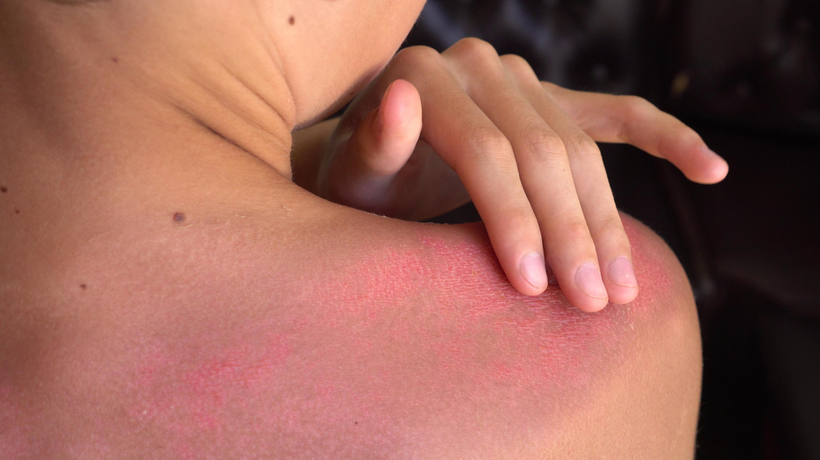As we reach the peak of summer it’s important to keep an eye on how your skin is reacting to sun exposure. A severe sunburn can easily turn into sun poisoning. According to UPMC Health Beat, it usually occurs during the summer months in people with a lighter skin tone because the skin does not produce enough melanin—the pigment that absorbs UV light. However, Dr. Kristeen Cherney says there are many other reasons your skin might be reacting to the sun, like living close to the equator or even taking antibiotics. If you’ve got any of these symptoms after a day in the sun, you might’ve stayed out just a little too long.
Itchy Blisters, Bumps or Rash
Notice a big red itchy spot on your skin? Don’t panic! It could possibly be a sun rash. Aside from a regular rash that would dry up and fall off, sun rashes could form blisters or bumps. Dr. Cherney says using some type of steroid cream could ease the side effects but if the pain becomes worse you might need to seek medical attention.
Peeling Skin
Similar to a regular sunburn, your skin may start to peel. It might be satisfying to pick at the wounds but it is not suggested! A medical review by Dr. Elaine Luo, M.D., says that it can be hard to tell the difference between sunburn and sun poisoning. However, it states that the main way to tell the difference is how badly your skin reacts to the burn.
Darkening of the Skin
According to the same medical review, Dr. Luo says in some cases of sun poisoning the skin may get slightly darker. This is called hyperpigmentation and may be a key sign in letting you know there is something going on with your skin.
Pain and Swelling
As with any burn, there will be some pain and swelling. Dr. Cherney says it is not uncommon for severe redness to accompany any pain you may have. With a little care symptoms usually go away on their own but prolonged itchiness or pain should be checked out by a professional.
Other common symptoms of sun poisoning may include:
- Swelling
- Large blisters
- Headache
- Fever
- Dizziness
- Confusion
- Nausea or vomiting
- Rapid pulse and breathing
- Fainting
- Dehydration
According to UPMC, these things can help improve your condition at home:
- Hydrate and take ibuprofen to manage the pain.
- Apply cold compresses made of equal parts milk and water, or infused with Burow’s solution will help soothe the skin, and aloe vera gel can serve as an alternative.
- Use cool (not cold) water when bathing and avoid scented items like lotions, bath salts, oils, and perfumes because they may react negatively with the burnt skin.
- Avoid the sun until you’re well, and take precautionary measures to avoid a similar situation!
Sources:



